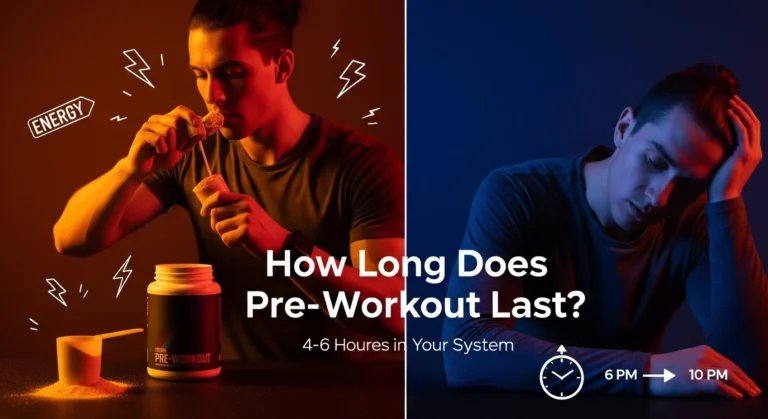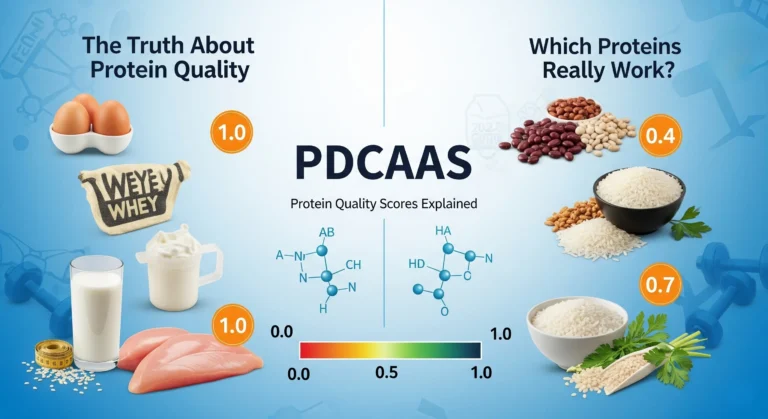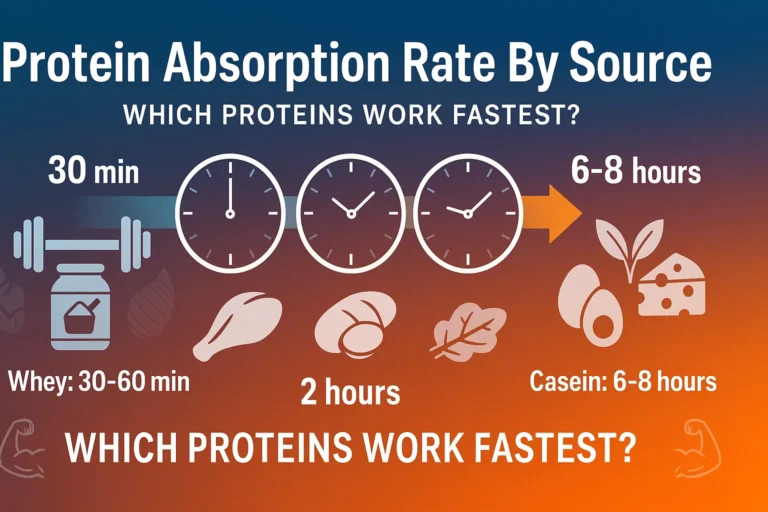
Did you know that 73% of gym-goers take their pre-workout at the wrong time, potentially wasting money and missing out on peak performance? I learned this the hard way after months of wondering why my energy would crash mid-workout or hit me too late!
Picture this: You’re pumped for leg day, you down your pre-workout, and then… nothing. Fifteen minutes into squats, you’re dragging yourself through sets that should feel explosive. Sound familiar? That was me for way too long until I figured out when to take pre-workout for optimal results.
The timing of your pre-workout supplement can make or break your training session. Whether you’re a morning warrior hitting the gym at 6 AM or an evening athlete squeezing in workouts after work, understanding when to take pre-workout supplements and how to time them properly is crucial for maximizing their benefits. In this comprehensive guide, I’ll share everything I’ve learned about pre-workout timing through years of trial and error, plus the science-backed strategies that actually work.
How Pre-Workout Supplements Work in Your Body
Let me tell you about the time I chugged my pre-workout right before walking into the gym. Big mistake! I spent the first 20 minutes of my workout waiting for the caffeine to kick in, completely wasting my warm-up and initial sets.
Here’s what’s actually happening in your body when you take pre-workout. Caffeine, the main player in most formulas, takes about 15-45 minutes to reach peak blood levels. But here’s the kicker – that timeline changes based on whether you’ve eaten recently. On an empty stomach, I’ve felt the effects in as little as 10 minutes. After a meal? Sometimes it takes a full hour.
Beta-alanine is another key ingredient that works differently. This amino acid builds up in your muscles over time, creating a buffer against lactic acid. The tingling sensation you feel? That’s normal and actually a good sign it’s getting to work. But unlike caffeine’s immediate effects, beta-alanine needs consistent timing to maintain optimal muscle levels.
Citrulline malate is all about that pump and blood flow. It converts to nitric oxide in your body, which dilates blood vessels for better nutrient delivery to muscles. This process typically takes 30-60 minutes to reach full effect, which is why timing matters so much for that coveted muscle fullness during training.
Your individual metabolism plays a huge role too. I’m what you’d call a “fast metabolizer” – caffeine hits me quick but also leaves my system faster. My training partner? She needs a full 45 minutes for the same pre-workout to kick in. There’s no one-size-fits-all approach here.
Age, body weight, and even genetics affect how quickly your body processes these ingredients. The CYP1A2 gene, for instance, determines how efficiently you metabolize caffeine. Fast metabolizers can handle more caffeine and need different timing than slow metabolizers who might feel jittery for hours.
The Optimal Pre-Workout Timing Formula
After experimenting with different timing strategies for months, I’ve developed what I call my “sweet spot formula.” For most people, taking pre-workout 20-30 minutes before training hits that perfect window where all ingredients reach peak effectiveness right when you need them most.
But let’s get specific because generic advice never worked for me. If you’re taking a high-caffeine pre-workout (300mg+), lean toward the 30-45 minute mark. Lower caffeine formulas (150-200mg) often work best at 15-25 minutes. I learned this after countless workouts where my timing was just slightly off, leaving me either under-energized or dealing with post-workout crashes.
The empty stomach versus with food debate is real, and I’ve tested both extensively. Empty stomach absorption is faster – usually 15-20 minutes for me to feel effects. But it also means more intense side effects like jitters or nausea if you’re sensitive. With food, absorption slows to 30-45 minutes, but the ride is smoother and lasts longer.
Here’s my personal timing calculation: I look at the caffeine content and divide by 10. So a 200mg caffeine pre-workout gets taken 20 minutes before I start lifting. A 300mg formula? 30 minutes. This isn’t scientific perfection, but it’s worked consistently for me and the people I’ve shared it with.
Morning workouts require special consideration. Your cortisol levels are naturally higher, which can amplify caffeine’s effects. I take my morning pre-workout 15 minutes earlier than usual to account for this. Evening sessions are trickier – you want the energy boost without the sleep disruption that comes later.
Individual factors like your coffee tolerance matter enormously. If you’re already drinking 2-3 cups daily, you might need longer for pre-workout to take effect since your adenosine receptors are partially blocked. Non-coffee drinkers often feel pre-workout effects much faster and stronger.
Pre-Workout Timing for Different Workout Types
Not all workouts are created equal, and neither should your pre-workout timing be. I discovered this during my marathon training phase when my usual 20-minute timing left me energized for the first hour but crashing during longer sessions.
For cardio sessions, especially steady-state cardio lasting 45+ minutes, I’ve found taking pre-workout 30-40 minutes beforehand works best. The sustained energy release aligns better with the longer duration. Sprint intervals or HIIT? Stick to the standard 15-20 minute window since you want maximum power output right from the start.
Strength training has been my main focus, and timing here is crucial for that mind-muscle connection. Twenty minutes before my first working set seems to be the magic number. This gives me peak focus during my heaviest lifts while maintaining energy throughout the entire session. I learned this after too many workouts where I felt amazing during warm-ups but flat during my main lifts.
For those brutal 90+ minute training sessions (looking at you, leg day), I’ve experimented with split dosing. Half the pre-workout 30 minutes before starting, then the other half about 45 minutes into the workout. This isn’t ideal for everyone, but it prevents the energy crash that can happen during longer sessions.
Competition day timing is completely different. The adrenaline and nerves change how your body processes stimulants. I take competition pre-workout 45 minutes before my first event, accounting for the heightened stress response that can speed up absorption. Plus, you want to avoid any bathroom emergencies during crucial moments!
Different training phases require timing adjustments too. During high-volume phases, I might push timing back slightly to ensure energy lasts through all sets. Strength phases with longer rest periods? Earlier timing works since I need peak power for fewer, more intense efforts.
Common Pre-Workout Timing Mistakes to Avoid
Let me save you from some painful lessons I learned the hard way. The biggest mistake I see people make? Taking pre-workout too close to bedtime. I once took my usual afternoon pre-workout at 6 PM for a 7 PM session and didn’t fall asleep until 2 AM. Never again!
The general rule I follow now: no stimulants within 6-8 hours of planned bedtime. But individual sensitivity varies wildly. My friend can take pre-workout at 8 PM and sleep fine by 11 PM. Me? Anything after 3 PM keeps me wired past midnight.
Another huge mistake is mixing pre-workout with certain foods or drinks. I learned this during a particularly awful workout where I took my pre-workout with a big glass of milk. The dairy slowed absorption significantly, and I felt sluggish instead of energized. Acidic foods like citrus can also interfere with caffeine absorption.
Stacking multiple stimulants without adjusting timing is dangerous territory. Energy drinks plus pre-workout, or pre-workout plus coffee taken too close together can lead to some seriously uncomfortable side effects. I space any additional caffeine at least 2-3 hours apart from pre-workout timing.
Ignoring your personal caffeine tolerance is setting yourself up for failure. When I first started taking pre-workout, I jumped straight to the highest dose because “more must be better,” right? Wrong. I spent that entire workout feeling anxious and jittery instead of focused and strong. Start with half doses and adjust timing and amount based on how you respond.
Not accounting for meal timing has derailed more workouts than I care to admit. That time I took pre-workout 20 minutes after a huge lunch? It took over an hour to feel any effects, and by then I was halfway through a lackluster training session.
How to Adjust Timing Based on Your Schedule
Real life doesn’t always align with optimal pre-workout timing, and I’ve had to get creative with scheduling over the years. Early morning workouts are probably the trickiest to time properly, especially if you’re not naturally a morning person.
For 5-6 AM gym sessions, I take my pre-workout immediately upon waking, then use the 20-30 minutes to get dressed, drive to the gym, and do a light warm-up. This timing has been a game-changer for morning energy levels. Some people prefer taking it the night before in individual doses and mixing it right when they wake up to save precious morning minutes.
Lunch break workouts require precise timing since you only have limited time. I take my pre-workout about 15 minutes before leaving the office, which puts me right in the sweet spot when I start lifting. The key is being consistent with this timing so your body knows what to expect.
Evening workouts after work are where most people struggle with timing. If you’re getting to the gym around 6-7 PM, taking pre-workout around 5:30 PM usually works well. But you have to consider your sleep schedule. I’ve switched to lower-stimulant or stimulant-free options for evening sessions to avoid sleep disruption.
Weekend workouts offer more flexibility, but don’t let that throw off your timing completely. I still try to maintain similar timing patterns to weekdays to keep my body’s response consistent. Plus, weekend workouts are often longer, so proper timing becomes even more important for sustained energy.
Travel completely messes with pre-workout timing, especially crossing time zones. I’ve learned to adjust gradually rather than trying to force my usual timing in a new time zone. When traveling east, I take pre-workout slightly earlier. Going west? I push it back a bit. The key is listening to your body’s natural rhythms rather than fighting them.
Signs Your Pre-Workout Timing Is Off
Learning to read your body’s signals has been crucial for dialing in perfect timing. Energy crashes mid-workout are usually the most obvious sign something’s wrong. If you’re feeling amazing for the first 20 minutes then hitting a wall, your timing might be too early, or you might need a different formula entirely.
Jitters without performance benefits typically mean you’re taking pre-workout too close to other stimulants or on too empty of a stomach. I experienced this frequently when I was drinking coffee in the morning and taking pre-workout in the afternoon without enough time between them.
Sleep disruption patterns tell you a lot about timing. If you’re consistently having trouble falling asleep on workout days, track when you’re taking your pre-workout. I keep a simple log on my phone noting pre-workout timing and sleep quality, which has helped me identify patterns I never would have noticed otherwise.
Digestive issues can also be timing-related. Taking pre-workout too close to meals, or on a completely empty stomach when you’re sensitive, can cause nausea or stomach discomfort during training. I’ve found that a small snack 45-60 minutes before pre-workout consumption helps with this.
When performance starts declining despite consistent training and nutrition, timing might be the culprit. Sometimes we get so used to a routine that we don’t notice gradual changes in effectiveness. Every few months, I reassess my timing and make small adjustments based on how my workouts have been feeling.
The “crash and burn” pattern is another red flag. If you’re consistently feeling exhausted 2-3 hours after taking pre-workout, especially if it’s affecting your evening routine or next day’s energy, your timing or dosage needs adjustment.
Conclusion
Finding the perfect pre-workout timing is like discovering your personal performance key – it takes some experimentation, but the results are worth it! Remember, the “best” timing varies from person to person based on your metabolism, workout schedule, and individual response to stimulants.
Start with the 20-30 minute rule on an empty stomach, then adjust based on how your body responds. Pay attention to your energy levels, focus, and sleep patterns to fine-tune your approach. Most importantly, consistency is key – once you find your optimal timing, stick with it for the best results.
The biggest lesson I’ve learned through all my timing experiments? There’s no perfect formula that works for everyone. What matters is finding YOUR perfect timing through careful observation and gradual adjustments. Don’t be afraid to experiment, but make changes slowly so you can clearly identify what works and what doesn’t.
Remember to consider your overall caffeine intake, meal timing, workout type, and sleep schedule when planning your pre-workout consumption. These factors all interact with each other, and small adjustments can make huge differences in your training quality.
Have you found your perfect pre-workout timing? Share your experience and any tips that have worked for you in the comments below!



